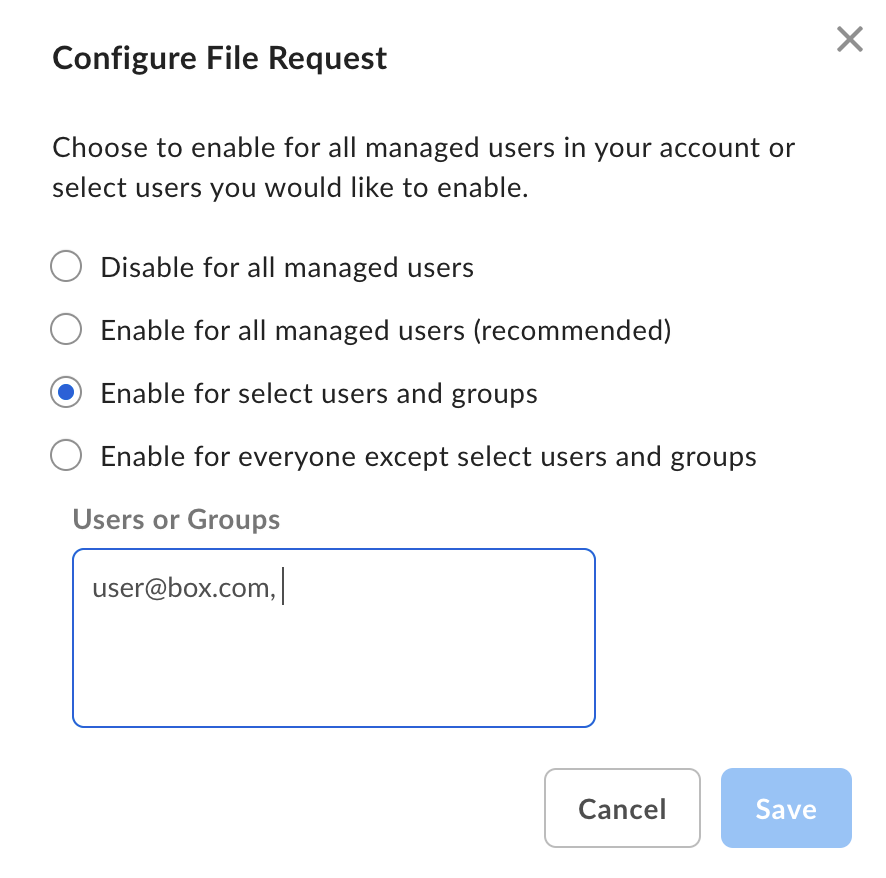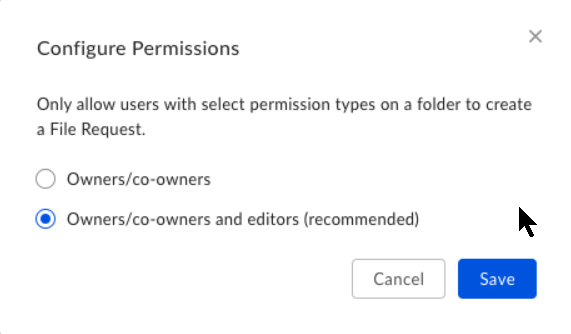Box File Request gives people in your organization a fast and secure way to request and obtain files, plus associated metadata, from anyone. Using an easy, drag-and-drop graphic interface, they create a web form that Box hosts. Then they get a shared link to the form they can send out to:
- Securely request files from anyone, no matter whether they have a Box account, without adding collaborators on a folder
- Solicit additional information with metadata form fields, which they can set as required/optional
- Enable extra security and tracking with link settings, as they would with any Box shared link
- Kick off automated workflows using Box Relay
People get started by identifying the Box folder they want to host the content they request. Box stores all requested content in that folder. Your organization’s Box policies determine the maximum file size someone can upload.
By default, file uploads are anonymous. However, you can require that uploaders log in to Box. This enables you to capture a valid email address with each upload.
Whoever creates a File Request form can also specify the metadata they wish to accompany the uploaded content. To do this, they identify an existing metadata template (one template per file request, and one file request per folder). Then they specify the specific attributes they wish to capture. The requested metadata attaches to each file upload. If the metadata template they use is subsequently changed or deleted, it does not automatically update the file request. You must remove the impacted metadata fields and add new fields.
By default, Box File Request is turned on for all managed users in your organization, and is available to folder owners, co-owners, and editors in your organization. People must have edit or above access to a folder to use File Request. You can configure which users have access to the feature, and you can configure whether to include editors, or limit access only to folder owners and co-owners. You can also disable the feature enterprise-wide.
File Request is available to anyone with a Box Business Plan account. However, no one needs a Box account to access the finished form and upload content.
Setting permissions
To adjust permissions for File Request throughout your organization:
- From your Admin Console, navigate to Enterprise Settings > Content & Sharing.
- Scroll down to the File Request section.
- By default, the new File Request experience is enabled for all managed users who are editors, owners, or co-owners of a folder.

- Specify the breadth of access to File Request. You can grant access to all your managed users or groups, only a subset of users or groups, or disable the feature entirely. To do this, click Configure Users, click the option you want, and then click Save.
Note:
- You can allow or deny up to 100 managed users and 100 groups.
- You can only select groups that have Permission Setting set to Admins Only. For details, see Creating and managing groups.

- Specify whether to limit File Request access to folder owners and co-owners (that is, to exclude editors), based on folder permissions. To do this, click Configure Permissions, click the option you want, and then click Save.

- Specify whether to require that the content uploader log in to their Box account before submitting their files. To do this, check Require uploaders to log in with a Box account. This setting:
- applies enterprise-wide; individual Box accountholders cannot change it.
- applies retroactively to all currently active File Requests, in addition to all future File Requests
- disables the option to add an email field to the File Request, as that option becomes redundant when you require a Box login before uploading.
- provides an option for people without a Box account to create one before they can submit.
Applying default custom branding
To learn how to apply default custom branding to new File Requests: see this article.
Notes
- File Request does not enable access to data in your Box account. It only collects files from other contributors.
- If you disable File Request for all managed users, you restrict the ability for anyone to create or edit a File Request. Any existing File Request links are still live, unless you disable or delete the individual file requests before you disable the feature.
Box File Request is fully-integrated with Box Tasks, Relay, and Notifications. For example, files uploaded via a File Request can be used to kick off an automated workflow in Relay.
People can also use Box File Request with your intranet, and as an upload embed widget.
You can also generate a user activity report to identify who has created, updated, or deleted a file request in your enterprise. To do this, from your Admin Console, navigate to Reports > Create Report > User Activity, and in the Action Types section scroll down to the File Request. However, you can only report on File Request activity dating back to June 4, 2020. Also, you can report only on requests using the revised version of File Request.
Finally, using Box APIs, you can programmatically copy an existing File Request and apply it to multiple folders, change File Request settings, or deactivate or delete File requests. For details, consult the Box File Request user guide and use cases, as well as the Box developer API Reference.
Related Links
Using File Request to get Content from Anyone
How Content Submitters View and Use File Request
Understanding Collaborator Permission Levels